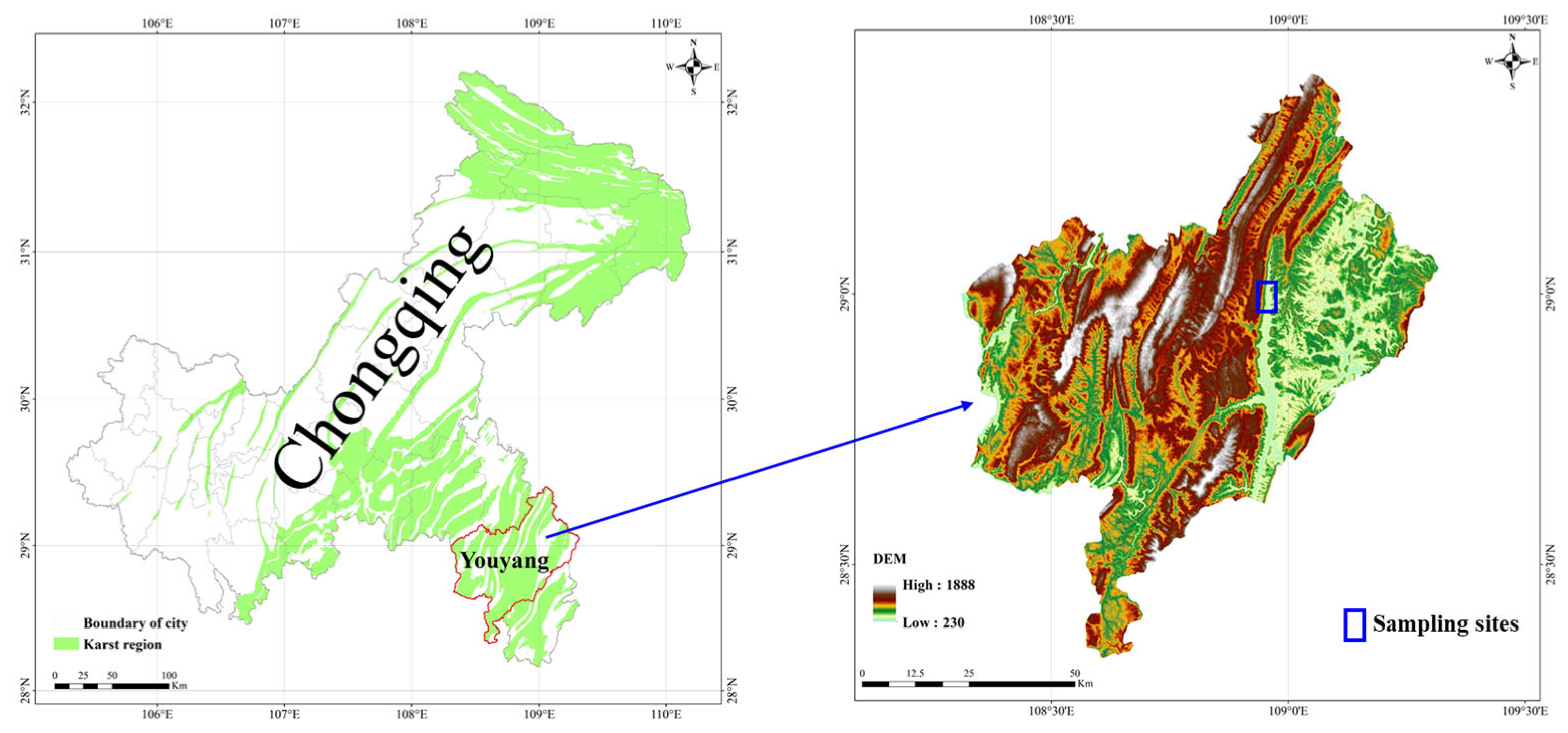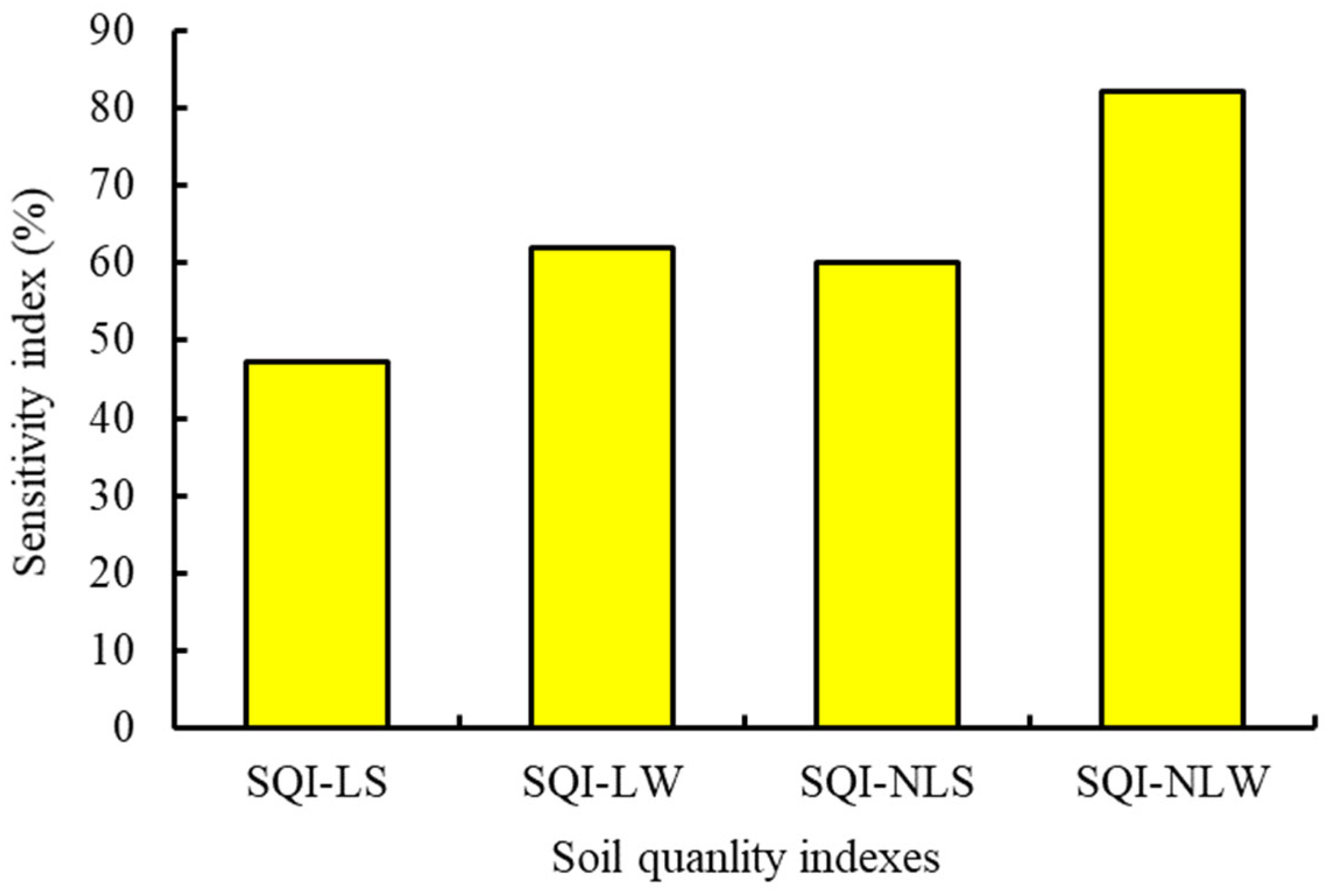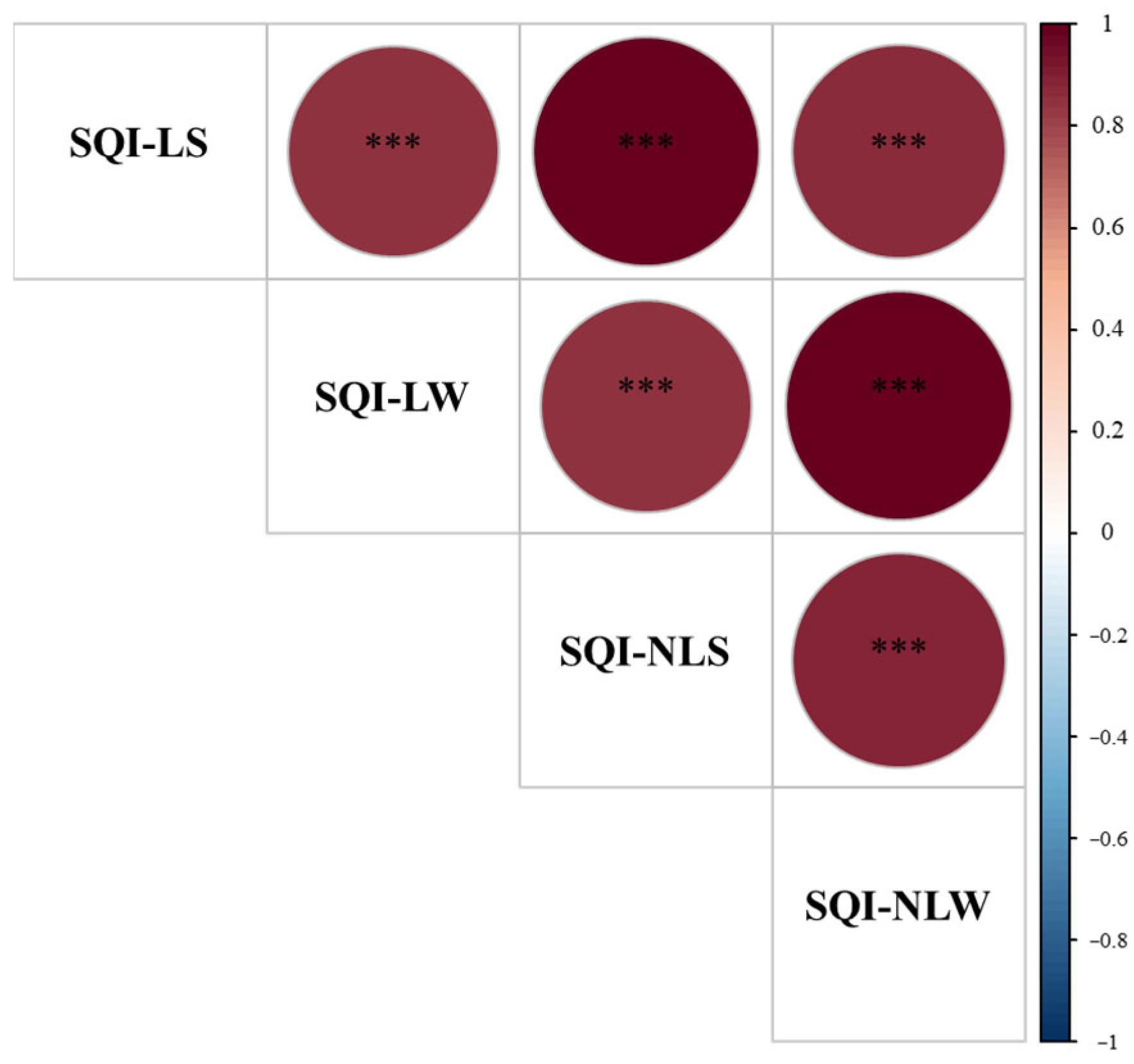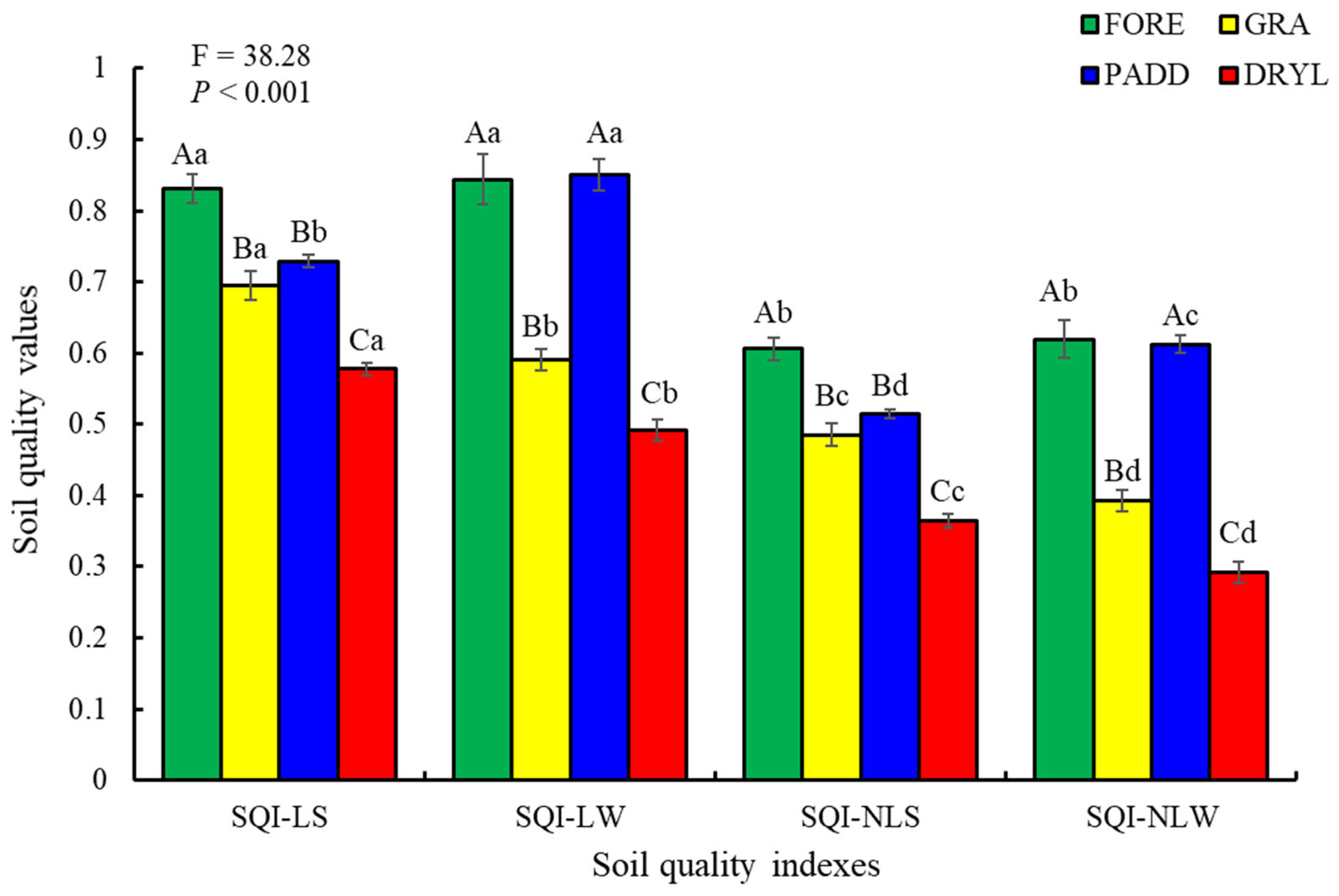Influence of Land Use Types on Soil Properties and Soil Quality in Karst Regions of Southwest China
Abstract
:1. Introduction
2. Materials and Methods
2.1. Study Area
2.2. Sampling Design
2.3. Soil Analysis
2.4. Calculate the Soil Quality Index
- Selecting the MDS;
- 2.
- Establishing the SQI;
- 3.
- The sensitivity index of SQI.
2.5. Statistical Analyses
3. Results
3.1. Contents of Soil Properties
3.2. The Soil Quality Index Based on MDS
3.3. Soil Quality under Different Land Uses
4. Discussion
4.1. Effect of Land Use Types on Soil Properties
4.2. Evaluation of SQ Using Different Soil Quality Indexes
5. Conclusions
Author Contributions
Funding
Data Availability Statement
Conflicts of Interest
Abbreviations
References
- Fu, R.Y.; Dai, L.C.; Zhang, Z.H.; Hu, G. Community assembly along a successional chronosequence in the northern tropical karst mountains, South China. Plant Soil 2023, 491, 317–331. [Google Scholar] [CrossRef]
- Yu, P.J.; Liu, J.L.; Tang, H.Y.; Sun, X.Z.; Liu, S.W.; Tang, X.G.; Ding, Z.; Ma, M.G.; Ci, E. Establishing a soil quality index to evaluate soil quality after afforestation in a karst region of Southwest China. Catena 2023, 230, 107237. [Google Scholar] [CrossRef]
- Febles-Gonzalez, J.M.; Vega-Carreno, M.B.; Tolon-Becerra, A.; Lastra-Bravo, X. Assessment of soil erosion in karst regions of Havana, Cuba. Land Degrad. Dev. 2012, 23, 465–474. [Google Scholar] [CrossRef]
- Peng, J.; Jiang, H.; Liu, Q.H.; Green, S.M.; Quine, T.A.; Liu, H.Y.; Qiu, S.J.; Liu, Y.X.; Meersmans, J. Human activities vs. climate change: Distinguishing dominant drivers on LAI dynamics in karst region of southwest China. Sci. Total Environ. 2021, 769, 144297. [Google Scholar] [CrossRef] [PubMed]
- Li, D.J.; Wen, L.; Xiao, K.C.; Song, T.Q.; Wang, K.L. Responses of soil gross nitrogen transformations to three vegetation restoration strategies in a subtropical karst region. Land Degrad. Dev. 2021, 32, 2520–2527. [Google Scholar] [CrossRef]
- Teng, L.D.; Jiang, G.H.; Ding, Z.L.; Wang, Y.; Liang, T.B.; Zhang, J.Z.; Dai, H.X.; Cao, F.B. Evaluation of tobacco-planting soil quality using multiple distinct scoring methods and soil quality indices. J. Clean. Prod. 2024, 441, 140883. [Google Scholar] [CrossRef]
- Yu, P.J.; Han, K.X.; Li, Q.; Zhou, D.W. Soil organic carbon fractions are affected by different land uses in an agro-pastoral transitional zone in Northeastern China. Ecol. Indic. 2017, 73, 331–337. [Google Scholar] [CrossRef]
- Alaboz, P.; Odabas, M.S.; Dengiz, O. Soil quality assessment based on machine learning approach for cultivated lands in semi-humid environmental condition part of Black Sea region. Arch. Agron. Soil Sci. 2023, 69, 3514–3532. [Google Scholar] [CrossRef]
- Özkan, B.; Dengiz, O.; Alaboz, P.; Kaya, N.S. A new hybrid approach to assessing soil quality using neutrosophic fuzzy-AHP and support vector machine algorithm in sub-humid ecosystem. J. Mt. Sci. 2023, 20, 3186–3202. [Google Scholar] [CrossRef]
- Karaca, S.; Dengiz, O.; Turan, İ.D.; Özkan, B.; Dedeoğlu, M.; Gülser, F.; Sargin, B.; Demirkaya, S.; Ay, A. An assessment of pasture soils quality based on multi-indicator weighting approaches in semi-arid ecosystem. Ecol. Indic. 2021, 121, 107001. [Google Scholar] [CrossRef]
- Dengiz, O.; Turan, D. Soil quality assessment for desertification based on multi-indicators with the best-worst method in a semi-arid ecosystem. J. Arid Land 2023, 15, 779–796. [Google Scholar] [CrossRef]
- Khasi, Z.; Askari, M.S.; Amanifar, S.; Moravei, K. Assessing soil structural quality as an indicator of productivity under semi-arid climate. Soil Tillage Res. 2024, 236, 105945. [Google Scholar] [CrossRef]
- Zahedifar, M. Assessing alteration of soil quality, degradation, and resistance indices under different land uses through network and factor analysis. Catena 2023, 222, 106807. [Google Scholar] [CrossRef]
- Yang, E.J.; Zhao, X.L.; Qin, W.; Jian, J.; Han, J.Q.; Zhang, M. Temporal impacts of dryland-to-paddy conversion on soil quality in the typical black soil region of China: Establishing the minimum data set. Catena 2023, 231, 107303. [Google Scholar] [CrossRef]
- Negis, H.; Seker, C.; Gumus, I.; Erci, V. Establishment of a minimum dataset and soil quality assessment for multiple reclaimed areas on a wind-eroded region. Catena 2023, 229, 107208. [Google Scholar] [CrossRef]
- Ferretti, G.; Rosinger, C.; Diaz-Pines, E.; Faccini, B.; Coltorti, M.; Keiblinger, K.M. Soil quality increases with long-term chabazite-zeolite tuff amendments in arable and perennial cropping systems. J. Environ. Manag. 2024, 354, 120303. [Google Scholar] [CrossRef]
- Damiba, W.A.; Gathenya, J.M.; Raude, J.M.; Home, P.G. Soil quality index (SQI) for evaluating the sustainability status of Kakia-Esamburmbur catchment under three different land use types in Narok County, Kenya. Heliyon 2024, 10, e25611. [Google Scholar] [CrossRef]
- Wang, Z.; Jia, L.; Yang, L.; Guo, Z.; Sang, W.; Lu, L.; Xiao, C. Assessment of the effects of fencing enclosure on soil quality based on minimum data set in Biru County of the Qinghai–Tibet Plateau, China. Agronomy 2023, 13, 1558. [Google Scholar] [CrossRef]
- Gabhane, V.V.; Ramteke, P.; Chary, G.R.; Patode, R.S.; Ganvir, M.M.; Chorey, A.; Tupe, A.R. Effects of long-term nutrient management in semi-arid Vertisols on soil quality and crop productivity in a cotton-greengram intercropping system. Field Crops Res. 2023, 303, 109115. [Google Scholar] [CrossRef]
- Nasir, M.J.; Haider, M.F.; Ali, Z.; Akhtar, W.; Alam, S. Evaluation of soil quality through simple additive soil quality index (SQI) of Tehsil Charsadda, Khyber Pakhtunkhwa, Pakistan. J. Saudi Soc. Agric. Sci. 2024, 23, 42–54. [Google Scholar]
- Bravo-Medina, C.; Goyes-Vera, F.; Arteaga-Crespo, Y.; Garcia-Quintana, Y.; Changoluisa, D. A soil quality index for seven productive landscapes in the Andean-Amazonian foothills of Ecuador. Land Degrad. Dev. 2021, 32, 2226–2241. [Google Scholar] [CrossRef]
- Okolo, C.; Gebresamuel, G.; Zenebe, A.; Haile, M.; Eze, P.N. Accumulation of carbon in various soil aggregate sizes under different land use systems in a semi-arid environment. Agric. Ecosyst. Environ. 2020, 297, 106924. [Google Scholar] [CrossRef]
- Yu, P.J.; Li, Y.X.; Liu, S.W.; Liu, J.L.; Ding, Z.; Ma, M.G.; Tang, X.G. Afforestation influences soil organic carbon and its fractions associated with aggregates in a karst region of Southwest China. Sci. Total Environ. 2022, 814, 152710. [Google Scholar] [CrossRef] [PubMed]
- Yu, P.J.; Liu, S.W.; Zhang, L.; Li, Q.; Zhou, D.W. Selecting the minimum data set and quantitative soil quality indexing of alkaline soils under different land uses in northeastern China. Sci. Total Environ. 2018, 616–617, 564–571. [Google Scholar] [CrossRef] [PubMed]
- Li, F.F.; Zhang, X.S.; Zhao, Y.; Song, M.J.; Liang, J. Soil quality assessment of reclaimed land in the urban-rural fringe. Catena 2023, 220, 106692. [Google Scholar] [CrossRef]
- Mamehpour, N.; Rezapour, S.; Ghaemian, N. Quantitative assessment of soil quality indices for urban croplands in a calcareous semi-arid ecosystem. Geoderma 2021, 382, 114781. [Google Scholar] [CrossRef]
- Yu, P.J.; Liu, J.L.; Tang, H.Y.; Ci, E.; Tang, X.G.; Liu, S.W.; Ding, Z.; Ma, M.G. The increased soil aggregate stability and aggregate-associated carbon by farmland use change in a karst region of Southwest China. Catena 2023, 231, 107284. [Google Scholar] [CrossRef]
- Bhatt, R.; Singh, P.; Sharma, S. Changes in soil organic pool and carbon preservation capacity of macro- and micro-aggregates in response to land use change in North-Western India. J. Soil Sci. Plant Nutr. 2023, 23, 2849–2867. [Google Scholar] [CrossRef]
- Vasilchenko, A.V.; Galaktionova, L.V.; Tretyakov, N.Y.; Dyachkov, S.M.; Vasilchenko, A.S. Impact of agricultural land use on distribution of microbial biomass and activity within soil aggregates. Soil Use Manag. 2023, 39, 618–633. [Google Scholar] [CrossRef]
- Han, C.; Song, M.X.; Tang, Q.; Wei, J.; He, X.B.; Collins, A.L. Post-farming land restoration schemes exhibit higher soil aggregate stability and organic carbon: Evidence in the Three Gorges Reservoir Area, China. Catena 2023, 227, 107099. [Google Scholar] [CrossRef]
- Zhong, Z.K.; Wu, S.J.; Lu, X.Q.; Ren, Z.X.; Wu, Q.M.; Xu, M.P.; Ren, C.J.; Yang, G.H.; Han, X.H. Organic carbon, nitrogen accumulation, and soil aggregate dynamics as affected by vegetation restoration patterns in the Loess Plateau of China. Catena 2021, 196, 104867. [Google Scholar] [CrossRef]
- Chen, Y.; Han, M.G.; Yuan, X.; Zhou, H.K.; Zhao, X.Q.; Schimel, J.P.; Zhu, B. Long-term warming reduces surface soil organic carbon by reducing mineral-associated carbon rather than “free” particulate carbon. Soil Biol. Biochem. 2023, 177, 108905. [Google Scholar] [CrossRef]
- Lin, S.X.; Liu, Z.J.; Wang, Y.C.; Li, J.Y.; Wang, G.G.; Zhang, W.; Wang, H.B.; He, H.B. Soil acidification associated with changes in inorganic forms of N reduces the yield of tea (Camellia sinensis). Arch. Agron. Soil Sci. 2023, 69, 1660–1673. [Google Scholar] [CrossRef]
- Liu, J.A.; Shu, A.P.; Song, W.F.; Shi, W.C.; Li, M.C.; Zhang, W.X.; Li, Z.Z.; Liu, G.R.; Yuan, F.S.; Zhang, S.X.; et al. Long-term organic fertilizer substitution increases rice yield by improving soil properties and regulating soil bacteria. Geoderma 2021, 404, 115287. [Google Scholar] [CrossRef]
- Yu, P.J.; Liu, S.W.; Xu, Q.; Fan, G.H.; Huang, Y.X.; Zhou, D.W. Response of soil nutrients and stoichiometric ratios to short-term land use conversions in a salt-affected region, northeastern China. Ecol. Eng. 2019, 129, 22–28. [Google Scholar] [CrossRef]
- Zhao, F.Z.; Kang, D.; Han, X.H.; Yang, G.H.; Feng, Y.Z.; Ren, G.X. Soil stoichiometry and carbon storage in long-term afforestation soil affected by understory vegetation diversity. Ecol. Eng. 2015, 74, 415–422. [Google Scholar] [CrossRef]
- Liu, S.B.; Li, F.D.; Zhang, Q.Y.; Li, Z.; Tian, C.; Qiao, Y.F.; Du, K.; Cheng, H.F.; Chen, G.; Li, X.Y. Soil quality improvement with increasing reclamation years in the Yellow River Delta. Agronomy 2023, 13, 2576. [Google Scholar] [CrossRef]
- Aranguren, R.; Canon, J. Assessing differential land use impacts on soil quality: A method based on log-response ratios and polygonal projections. J. Environ. Manag. 2023, 348, 119442. [Google Scholar] [CrossRef] [PubMed]
- Iskandar, I.; Suryaningtyas, D.T.; Baskoro, D.P.T.; Budi, S.W.; Gozali, I.; Saridi, S.; Masyhuri, M.; Dultz, S. The regulatory role of mine soil properties in the growth of revegetation plants in the post-mine landscape of East Kalimantan. Ecol. Indic. 2022, 139, 108877. [Google Scholar] [CrossRef]
- Dong, X.D.; Yang, L.Y.; Harbo, L.S.; Yan, X.Y.; Chen, J.; Zhao, C.C.; Xiao, Y.T.; Liu, H.; Wang, S.L.; Miao, Y.; et al. Effects of land use on soil microbial community structure and diversity in the Yellow River floodplain. J. Plant Ecol. 2023, 16, rtac075. [Google Scholar] [CrossRef]
- Sahu, C.; Mishra, R.; Basti, S. Land use change affects carbon storage and lability in tropical soil of India. Geoderma Reg. 2023, 32, e00621. [Google Scholar] [CrossRef]





| Soil Indicators | FOR | GRA | PADD | DRYL | ANOVA | |
|---|---|---|---|---|---|---|
| F | p | |||||
| MAC | 63.32 ± 1.69 A | 52.38 ± 3.25 B | 47.77 ± 0.49 B | 23.42 ± 1.77 C | 67.62 | <0.001 *** |
| MIC | 22.79 ± 1.37 D | 28.77 ± 1.11 C | 33.17 ± 0.59 B | 43.00 ± 0.42 A | 80.32 | <0.001 *** |
| GMD | 0.73 ± 0.04 A | 0.50 ± 0.07 B | 0.43 ± 0.01 B | 0.17 ± 0.01 C | 31.65 | <0.001 *** |
| MWD | 1.70 ± 0.04 A | 1.42 ± 0.08 B | 1.31 ± 0.01 B | 0.69 ± 0.05 C | 64.28 | <0.001 *** |
| Soil pH | 7.27 ± 0.06 A | 6.33 ± 0.12 B | 6.30 ± 0.08 B | 5.46 ± 0.05 C | 82.87 | <0.001 *** |
| SOC | 31.55 ± 1.07 A | 26.76 ± 0.29 B | 32.94 ± 0.27 A | 26.89 ± 0.20 B | 29.89 | <0.001 *** |
| MACC | 33.61 ± 1.52 A | 27.02 ± 0.37 B | 34.96 ± 0.34 A | 29.11 ± 0.17 B | 21.56 | <0.001 *** |
| Free MAOC | 27.54 ± 0.51 A | 25.81 ± 0.23 B | 27.37 ± 0.26 A | 25.18 ± 0.22 B | 12.57 | 0.001 ** |
| SLC | 5.73 ± 0.36 A | 3.32 ± 0.13 B | 6.44 ± 0.22 A | 2.79 ± 0.14 B | 59.02 | <0.001 *** |
| TN | 2.15 ± 0.14 B | 1.57 ± 0.08 C | 2.73 ± 0.06 A | 1.66 ± 0.03 C | 36.90 | <0.001 *** |
| TP | 0.54 ± 0.03 B | 0.49 ± 0.03 B | 0.67 ± 0.05 A | 0.49 ± 0.01 B | 7.34 | 0.005 ** |
| C/N | 14.74 ± 0.53 B | 17.16 ± 0.69 A | 12.09 ± 0.24 C | 16.17 ± 0.24 AB | 22.13 | <0.001 *** |
| C/P | 58.74 ± 2.22 A | 54.90 ± 2.88 AB | 49.74 ± 3.21 B | 55.14 ± 1.39 AB | 2.15 | 0.147 |
| Soil Indicators | PC1 | PC2 |
|---|---|---|
| MAC | 0.77 | 0.62 |
| MIC | −0.72 | − 0.68 |
| GMD | 0.73 | 0.67 |
| MWD | 0.77 | 0.62 |
| Soil pH | 0.78 | 0.52 |
| SOC | 0.91 | −0.38 |
| MACC | 0.82 | −0.49 |
| Free MAOC | 0.91 | −0.02 |
| SLC | 0.95 | −0.26 |
| TN | 0.80 | −0.58 |
| TP | 0.64 | −0.58 |
| C/N | −0.71 | 0.68 |
| Eigenvalue | 7.64 | 3.52 |
| Variance | 63.63 | 29.34 |
| Cumulative | 63.63 | 92.97 |
Disclaimer/Publisher’s Note: The statements, opinions and data contained in all publications are solely those of the individual author(s) and contributor(s) and not of MDPI and/or the editor(s). MDPI and/or the editor(s) disclaim responsibility for any injury to people or property resulting from any ideas, methods, instructions or products referred to in the content. |
© 2024 by the authors. Licensee MDPI, Basel, Switzerland. This article is an open access article distributed under the terms and conditions of the Creative Commons Attribution (CC BY) license (https://creativecommons.org/licenses/by/4.0/).
Share and Cite
Ma, L.; Si, H.; Li, M.; Li, C.; Zhu, D.; Mao, Z.; Yan, Y.; Jiang, K.; Yu, P. Influence of Land Use Types on Soil Properties and Soil Quality in Karst Regions of Southwest China. Agronomy 2024, 14, 882. https://doi.org/10.3390/agronomy14050882
Ma L, Si H, Li M, Li C, Zhu D, Mao Z, Yan Y, Jiang K, Yu P. Influence of Land Use Types on Soil Properties and Soil Quality in Karst Regions of Southwest China. Agronomy. 2024; 14(5):882. https://doi.org/10.3390/agronomy14050882
Chicago/Turabian StyleMa, Lei, Hongtao Si, Manyi Li, Cheng Li, Dongxue Zhu, Zheng Mao, Youlong Yan, Ke Jiang, and Pujia Yu. 2024. "Influence of Land Use Types on Soil Properties and Soil Quality in Karst Regions of Southwest China" Agronomy 14, no. 5: 882. https://doi.org/10.3390/agronomy14050882





